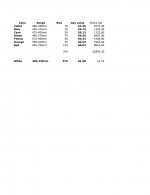Ron,
Many thanks! That's great. :t::t:
I think you're using data for the 8.5x44 HHS, left side. (I would post left and right transmission charts if anyone were interested. Otherwise, I'll just blab on.)
Just to check first, I normalized the seven numbers you provided by the width of the frequency bands and calculated an overall average. This should correspond to the white value of 61.6. It came out to be 61.7, which is within rounding error.
=================================================================
Okay, so what does it all mean?
The numbers refer to the estimated brightness percepts of a standard observer when presented with the spectral energy emitted from the exit pupil of the binocular. Of course, this is only a sample binocular, so there will be inter-sample variations as well as inter-tube variation for the same instrument. Basically, the ubiquitous "daylight" value simply refers to the how bright our standard observer would think the image to be
by comparison with the same image unfettered by the instrument, i.e., if he were m (= magnification) times closer and not using binoculars. It probably also corresponds with the impression of open field brightness with and without the instrument.
The additional day (photopic) color values speak to seven standard colors, and provide insight into how the standard observer would perceive color bias of the instrument. In this case, the emphasis would be in the orange-red area. It's only a benchmark, of course, because we each have different color perception.
If manufacturers were to provide these eight numbers (or something similar) for all models and upgrades, it would be a lot easier to make comparative evaluations by spec. Dream on, huh? :-O
I'm pretty much finished. It's been a great thread. And, by the way, this part of the discussion is extremely relevant to understanding why backa may not be so bad. Compare the numbers from the standard observer's perspective.
Ed
PS. The phrase "Standard Observer" has special meaning, which is described in the .pdf attachment. Unfortunately, we must enter this domain if we are ever to document, understand, and discuss relative image brightness and color tint distinctions between binoculars. Here are some extensions of standard observer technology for use with modern display equipment.
http://citeseerx.ist.psu.edu/viewdoc/summary?doi=10.1.1.139.4295 The author was a colleague of mine before I retired.





